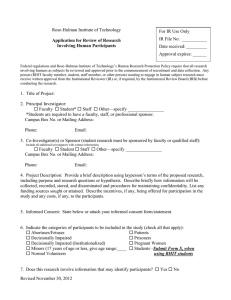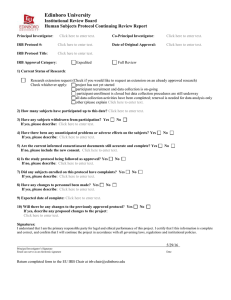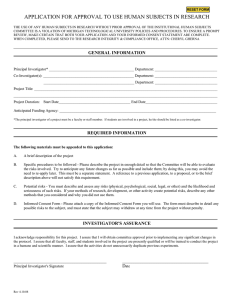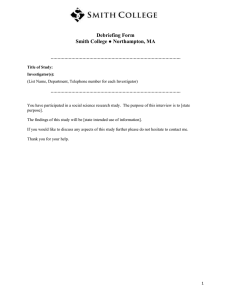OHR-2A ADDENDUM SUMMARY OF HUMAN SUBJECTS RESEARCH PROTOCOL
advertisement
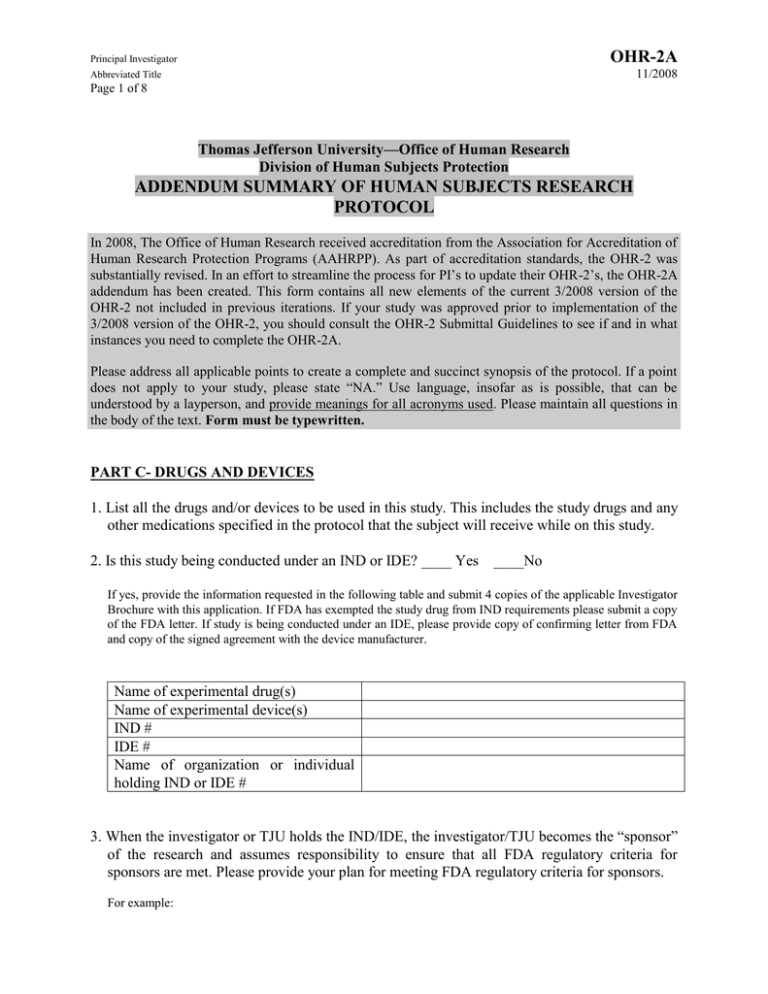
OHR-2A Principal Investigator 11/2008 Abbreviated Title Page 1 of 8 Thomas Jefferson University—Office of Human Research Division of Human Subjects Protection ADDENDUM SUMMARY OF HUMAN SUBJECTS RESEARCH PROTOCOL In 2008, The Office of Human Research received accreditation from the Association for Accreditation of Human Research Protection Programs (AAHRPP). As part of accreditation standards, the OHR-2 was substantially revised. In an effort to streamline the process for PI’s to update their OHR-2’s, the OHR-2A addendum has been created. This form contains all new elements of the current 3/2008 version of the OHR-2 not included in previous iterations. If your study was approved prior to implementation of the 3/2008 version of the OHR-2, you should consult the OHR-2 Submittal Guidelines to see if and in what instances you need to complete the OHR-2A. Please address all applicable points to create a complete and succinct synopsis of the protocol. If a point does not apply to your study, please state “NA.” Use language, insofar as is possible, that can be understood by a layperson, and provide meanings for all acronyms used. Please maintain all questions in the body of the text. Form must be typewritten. PART C- DRUGS AND DEVICES 1. List all the drugs and/or devices to be used in this study. This includes the study drugs and any other medications specified in the protocol that the subject will receive while on this study. 2. Is this study being conducted under an IND or IDE? ____ Yes ____No If yes, provide the information requested in the following table and submit 4 copies of the applicable Investigator Brochure with this application. If FDA has exempted the study drug from IND requirements please submit a copy of the FDA letter. If study is being conducted under an IDE, please provide copy of confirming letter from FDA and copy of the signed agreement with the device manufacturer. Name of experimental drug(s) Name of experimental device(s) IND # IDE # Name of organization or individual holding IND or IDE # 3. When the investigator or TJU holds the IND/IDE, the investigator/TJU becomes the “sponsor” of the research and assumes responsibility to ensure that all FDA regulatory criteria for sponsors are met. Please provide your plan for meeting FDA regulatory criteria for sponsors. For example: Principal Investigator Abbreviated Title OHR-2A 11/2008 Page 2 of 8 Investigator who holds an IND or IDE will assign some or all responsibilities to meet FDA sponsor requirements to a contract research organization (CRO). Investigator will undergo an audit by a CRO to ensure that procedures are in place so that all FDA regulatory requirements of sponsors will be met. Investigator will assign responsibility of compliance with some FDA regulatory requirements to a CRO and investigator will obtain an audit from a CRO to ensure that procedures are in place so that all other FDA regulatory requirements of sponsors will be met. NOTE: If you intend to use someone who is in-house and who has expertise on sponsor requirements, please justify that that person has equivalent expertise to a CRO. DRUGS 4. If test article is a drug, provide the following information: Class of drug (i.e., anti-hypertensive, anti-emetic, etc.) Mechanism of action (i.e., beta-adrenergic receptor blocker, anti cytokine, monoclonal antibody, etc.). 5. Will the study drug be dispensed by the Investigational Drug Service (IDS)? ______ Yes ______ No NOTE: The IDS must receive, track, and dispense drugs for all in-patient clinical trials. If this is an out-patient study and the IDS is not dispensing the study drug, please provide answers to each of the following: Where drug will be stored Who will have access to drug Who will maintain drug accountability logs, and dispense drug What measures to maintain security of drug storage and access are in place Please include a copy of the form you will use for documenting investigational drug receipt, storage and dispensing. 6. Is the sponsor providing the test article free of charge? If not, who will cover costs of the drug and its administration, if applicable? 7. If sponsor is not supplying test article, is it listed in the TJUH formulary? If not, where will it be obtained and who will pay for it? 8. Please briefly summarize relevant human clinical data for the study drug. 9. Please list the known side effects for each study drug. 10. Does this study include an off-label use of an FDA-approved drug? If yes, please explain. OHR-2A Principal Investigator 11/2008 Abbreviated Title Page 3 of 8 If you do not have an IND#, please certify that you meet all of the following FDA criteria for waiver of this requirement for the off-label use in question: [ ] It is not intended to be reported to FDA in support of a new indication for use or to support any other significant change in the labeling for the drug; [ ] It is not intended to support a significant change in the advertising for the product; [ ] It does not involve a route of administration or dosage level, use in a subject population, or other factor that significantly increases the risks (or decreases the acceptability of the risks) associated with the use of the drug product; [ ] It is conducted in compliance with the requirements for IRB review and informed consent [21 CFR parts 56 and 50, respectively]; [ ] It is conducted in compliance with the requirements concerning the promotion and sale of drugs [21 CFR 312.7]; and [ ] It does not intend to invoke an exception for informed consent requirements for emergency research [21 CFR 50.24]. DEVICES 11. Will the device be purchased via Supply Chain Management? [ If no, please address the following: ] YES [ ] NO Where will the device be stored? What security measures are in place to prevent the device from being used in a patient who is not enrolled in the research study or by a physician not involved in the study? Provide details as to how device will be tracked (logged in, stored, assigned to subject, implanted, etc.) 12. Who will teach investigators how to use the device (if applicable)? 13. Who will determine competence of the research team with respect to device use? 14. Federal Regulations at 21 CFR part 812 describe two types of devices, Significant Risk (SR) and Non-Significant Risk (NSR). The initial assessment as to a device being NSR is made by the sponsor who then supplies the IRB with all information, including any correspondence with the FDA, necessary to support that designation. The IRB is required to make an independent assessment regarding device risk. With respect to this study, the device fulfills requirements for: ________ a significant risk device (requires an IDE# from the FDA and IRB approval) ________ a non-significant risk device Principal Investigator Abbreviated Title OHR-2A 11/2008 Page 4 of 8 ________ an abbreviated IDE or IDE exemption 15. If device is NSR, provide the rationale for the designation and any relevant correspondence from the sponsor. 16. If a NSR device study, please document approval and risk assessments by other IRBs, if applicable(copies of correspondence should be available from the sponsor). 17. For Device Studies, certify below that you will meet the responsibility requirements for investigators found at 21 CFR 812 subpart E (http://www.accessdata.fda.gov/scripts/cdrh/cfdocs/cfCFR/CFRSearch.cfm?CFRPart=812&showFR=1&subpartNod e=21:8.0.1.1.9.5) [ [ [ [ ] Study will be performed according to the signed agreement with the sponsor ] Study will not be initiated until FDA and IRB approval is obtained ] Informed consent will be obtained from all subjects after FDA and IRB approval is obtained ] Any financial conflicts of interest will be disclosed prior to starting the study and updated as appropriate during the conduct of the study [ ] Device will be disposed of as per sponsor directions and any remaining unused devices will be returned to the sponsor 18. Is the sponsor providing the device free of charge? If not, who will pay for it? 19. Please briefly summarize relevant human clinical data for the study device. 20. Please list the known or potential side effects for the device. 21. Please briefly summarize relevant human clinical data for the study procedures. PART D - RISKS, BENEFITS, AND ALTERNATIVES 1. What are the risks of the research? (please note: this is not the same as the description of the known side effects of the test article(s) 2. Discuss measures taken to minimize risks and maximize benefits associated with this study.. 3. What are the potential benefits of participation? 4. Explain how the risks of the research are justified by potential benefit to the subject or society. 5. How would you treat this patient in a non-investigational setting? Please describe the treatment that is considered standard of care, as well as any alternative procedures or drugs or other courses of therapy that might be used, if such alternatives exist (include palliative care). OHR-2A Principal Investigator 11/2008 Abbreviated Title Page 5 of 8 6. How do the risks and side effects of the standard therapies compare to those associated with the study therapy? 7. If this is a placebo controlled trial, please provide rationale for use of placebo. 8. If subjects will not receive standard of care, provide rationale for this and address risks of not receiving standard of care. 9. Please address any risks associated with a “washout” period if applicable. PART E - CHILDREN 1. Address one of the three following risk categories A. ______ Minimal risk (risks are not greater than those ordinarily encountered in daily life or during the performance of routine physical or psychological examinations) Describe why this study should be considered minimal risk. Please describe any potential benefits that justify anticipated risks. B. ______ Greater than minimal risk Does the study present the prospect of direct benefit to individual subjects either by the procedure or by the type of monitoring the subject will receive? Yes_____No____ Assess the risks/benefits of the research as opposed to available alternative treatments/approaches. C. _______ The research poses a minor increase over minimal risk and offers no prospect of direct benefit to subjects Describe what generalizeable knowledge may be gained about the subject’s condition and how this will be applied with respect to the understanding or amelioration of the subjects’ disorder or condition Describe the risks inherent in the actual or expected medical, dental, psychological, social or educational situations, and justify the minor increase in risk with respect to the proposed treatment/intervention Principal Investigator Abbreviated Title OHR-2A 11/2008 Page 6 of 8 PART F – RECRUITMENT, EQUITABLE SELECTION, AND CONSENT PROCESS 1. Discuss the recruitment plan and describe recruitment methods and materials (e.g., physician referral, newspaper ad, radio, TV spot, e-mail, etc.). Please attach all relevant materials for IRB review and approval. Advertising and recruitment materials using the TJU or TJUH logo must be submitted to the Trademark Committee for approval. Call the Office of University Counsel at 955-8585 for information. 2. Will all qualified subject populations have adequate access to recruitment materials? Please explain. 3. Is the location and cultural setting of the research equally accessible to all qualified subject populations? If not, what can be done to make the location and setting more accessible? 4. If you are requesting a waiver of written consent, describe the information that will be provided to participants. 5. Who will conduct the consent interview? 6. Who will provide consent or permission (e.g., subject, legally authorized representative, parent, caregiver, etc.)? 7. Where will the consent interview take place? 8. Provide a step-by-step description of the consent process. 9. Describe your plan to assess a person’s capacity to consent. 10. Will you seek assent from decisionally-impaired individuals? If so, describe your plan for obtaining assent. 11. Will the potential subject be informed of the research or be provided a copy of the consent to review prior to the actual time of consent? If so, how much time in advance? How much time will be available for the consent process? 12. What provisions will be made if the potential subject does not wish to proceed with the consent interview at the first encounter? 13. If the potential subject does not understand spoken English, will an interpreter be present? YES ______NO ______ 14. Is surrogate consent involved? YES ______ NO ______ Principal Investigator OHR-2A Abbreviated Title 11/2008 Page 7 of 8 15. Will subjects be paid or receive any other inducements for participating? If yes, please explain. Please note that payment of subjects must be on a pro-rated basis unless there are compelling reasons not to prorate. There cannot be a requirement to finish all visits in order for subjects to be paid, as this is considered coercive. 16. Describe any steps taken to minimize the possibility of coercion or undue influence. PART H - LOCATION/COLLABORATION 1. If the investigator is the lead investigator or TJU is the lead site in a multi-site study, please address the following: Where is the repository for adverse events and unanticipated problems and how will information be disseminated to other sites? Who will tabulate and disseminate interim results? Who will provide information to other sites concerning protocol modifications? Describe how information that is relevant to participant safety will be managed (i.e., notifying site investigators of SAEs and Unanticipated Problems Involving Risks to Subjects or Others, communicating DSMB or Interim Reports, etc.) OHR-2A Principal Investigator 11/2008 Abbreviated Title Page 8 of 8 PART I - CERTIFICATION Federal Regulations require the following responsibilities of the Principal Investigator. Please check those items to which you have conformed, and sign. As Principal Investigator, I certify that: (check appropriate boxes) I have read the IRB Policy and Procedures Manual. I understand the federally-mandated responsibilities of a research investigator in conducting a clinical protocol. I will conduct this clinical protocol in accordance with these responsibilities. I will consent all subjects with an IRB-approved consent form, if applicable to the project, and store the consent forms in a safe repository. I will provide all subjects with a copy of their signed and dated consent form. All personnel have been appropriately trained for their assigned roles in this research. If this study utilizes an investigational agent(s), the dose(s) of the agent(s) cited in the IRB internal forms and the consent form agrees with the dose(s) cited in the protocol. _________________________________ ___________ Signature of principal investigator date
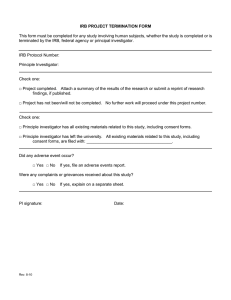
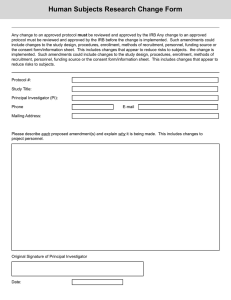
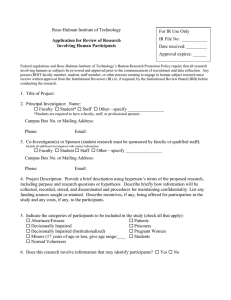
![Lesson Study Project Informed Consent for Students 2011-12 [TEMPLATE]](http://s2.studylib.net/store/data/011897429_1-e9cd20ac12fa907a0c9dbbb5866bfc98-300x300.png)
